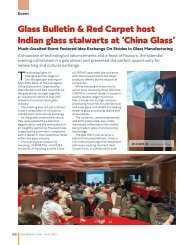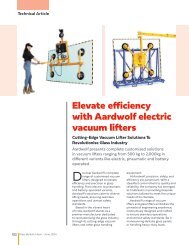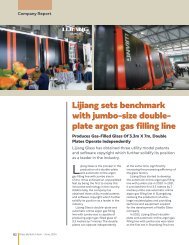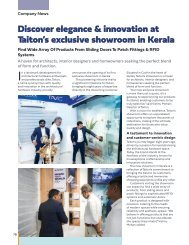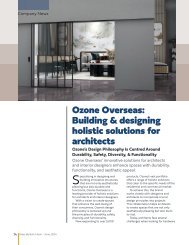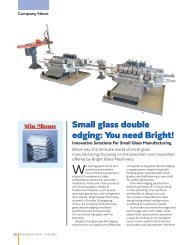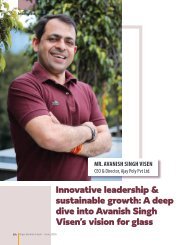Edition 57 (Jan-Mar, 2020)
You also want an ePaper? Increase the reach of your titles
YUMPU automatically turns print PDFs into web optimized ePapers that Google loves.
Project Hunt
Image ©Inho Rhee
staggered panels on the concave and
convex surfaces catch the light.
Quality glass from China’s
top supplier
The façade glass for this masterpiece
was produced by China-based CSG
Holding, which has a reputation on
both the national and international
markets for producing energy-saving
glass.
CSG Holding is well equipped with
technology and tools to deliver glass
with the best optical quality, flatness
and minimum roller wave. In line with
evolving market demands, CSG invests
continuously in the latest technology to
produce glass to the highest standard.
Over the past years, the company
has ordered more than 20 tempering
lines from Glaston and several preprocessing
machines.
Building with environmental
impact
With the curved form, the cost for the
glass curtain was higher, but in terms
of structural efficiency benefits, it
saved millions in steel and concrete.
Plus, it reduced the environmental
impact of the building considerably.
“Part of our success with this
particular building was its focus on a
sustainable design concept. We utilized
high-performance, double-glazing
with a low-E coating and incorporated
an insulated panel between each
glass, thereby cutting heating and airconditioning
costs,” Lee says.
“Glass is always going to be very
much in high demand for any kind
of building, because people want to
have that engagement – the incredible
views and a sense of daylighting –
which is very beneficial for well-being.
Especially if you are able to mitigate
the glare and heat loss or gain,
depending on the climate, you can save
on energy costs,” he continues.
Glass technology is continuously
looking for new ways to increase
building performance. For example,
triple-glazing can be applied
successfully in cold climates. The
solar gain in a building with a glass
curtain wall of almost 90% glass can be
used to produce the heat in a heatingdominated
climate. It is also possible
to have a very high percentage of
insulation in these buildings.
“As glass technologies continue to
advance and become more developed,
we’ll see a higher usage of vacuum
insulating, triple glazing, or even new
thoughts on curved glazing to help
the glass become more structurally
optimized. Also, thin glasses might
be used more in multiple-layer
assemblies,” he predicts.
The Tianjin Finance Centre is not
only a masterpiece of innovation, it
also makes a strong statement that
skyscrapers can truly meet the trends
in sustainable construction.
--------------------------------------------------
Source: www.glastory.net
--------------------------------------------------
Email: info@glaston.net
Website: www.glaston.net
90 Glass Bulletin | January - March, 2020






